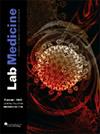Head and Neck Pain, Syncopal Episode, Abnormal Cerebrospinal Fluid, and Hyponatremia in a Middle-Aged Woman
IF 1
4区 医学
Q4 MEDICAL LABORATORY TECHNOLOGY
引用次数: 0
Abstract
1. Important clinical information includes neck pain, the absence of fever or focal neurologic signs, and syncopal episode. The most striking laboratory findings include the abnormal chemical and cytologic analysis of the cerebrospinal fluid (CSF) sample (hypoglycorrhachia, proteinorrhachia, and pleocytosis) and mild hyperglycemia. 2. Hypoglycorrhachia: The CSF is normally a clear, colorless, and virtually acellular fluid that is actively produced by the choroid plexus and ependymal cells lining the central nervous system (CNS) ventricles and subarachnoidal space through a process of ultrafiltration of plasma. Glucose levels in the CSF are 60% to 70% those of the serum; therefore, comparison between both values is paramount in interpreting abnormal results. Increased CSF glucose (hyperglycorrhachia) may be seen in the context of hyperglycemia or be due to a traumatic tap. Conversely, decreased CSF glucose (hypoglycorrhachia) is commonly found in untreated bacterial, fungal, tuberculous, or amoebic meningitis, and rarely in some viral CNS infections (particulary those caused by mumps and lymphocytic choriomeningitis viruses). Other causes of hypoglycorrhachia include CNS sarcoidosis and neoplasms (primary or metastatic). Proteinorrhachia: The normal CSF protein level is about 1% of the serum protein level. Increased levels are seen with most infections involving the meninges and the CNS, but are Clinical History头颈疼痛、晕厥发作、脑脊液异常和低钠血症一例中年妇女
1. 重要的临床信息包括颈部疼痛、无发热或局灶性神经体征和晕厥发作。最显著的实验室发现包括脑脊液(CSF)样本的异常化学和细胞学分析(低糖血症、蛋白血症和多细胞症)和轻度高血糖。2. 低糖下丘脑:脑脊液通常是一种透明、无色、几乎无细胞的液体,由沿中枢神经系统(CNS)脑室和蛛网膜下腔排列的脉络膜丛和室管膜细胞通过血浆超滤过程产生。脑脊液中的葡萄糖水平是血清的60% - 70%;因此,两个值之间的比较对于解释异常结果至关重要。脑脊液葡萄糖升高(高糖血症)可能在高血糖的情况下或由于创伤性穿刺而出现。相反,脑脊液葡萄糖降低(低糖下achia)常见于未经治疗的细菌性、真菌性、结核性或阿米巴性脑膜炎,而很少见于某些病毒性中枢神经系统感染(特别是由腮腺炎和淋巴细胞性脉络丛脑膜炎病毒引起的感染)。低糖下咽的其他原因包括中枢神经系统结节病和肿瘤(原发性或转移性)。蛋白血症:正常脑脊液蛋白水平约为血清蛋白水平的1%。在大多数涉及脑膜和中枢神经系统的感染中,可看到水平升高,但临床病史
本文章由计算机程序翻译,如有差异,请以英文原文为准。
求助全文
约1分钟内获得全文
求助全文
来源期刊

Labmedicine
医学-医学实验技术
CiteScore
2.50
自引率
0.00%
发文量
155
审稿时长
>12 weeks
期刊介绍:
Lab Medicine is a peer-reviewed biomedical journal published quarterly by the ASCP and Oxford University Press. The journal invites submission of manuscripts on topics related to clinical chemistry and microbiology, hematology, immunology, transfusion medicine, molecular diagnostics, cytology, histology, and laboratory administration and management. Original research, reviews, and case reports are considered for publication. Lab Medicine is indexed (under the title Laboratory Medicine) by the National Library of Medicine and is included in the PubMed database.
 求助内容:
求助内容: 应助结果提醒方式:
应助结果提醒方式:


